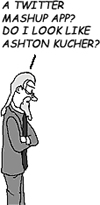About this book
You can think of this book as a two- or three-day workshop, transcribed into book form—and much cheaper! The stick figure character is a stand-in for me teaching the workshop, and the cartoon characters are your classmates. The questions they’ll ask or the opinions they express may be your own.
I have two goals for this book: first, to teach Flex 4 in a way that exposes you to real-world Flex problems in an accessible way, and second, to have a bit of fun with this book, without being cutesy, distracting, or insulting. The purpose of the cartoons in this introductory section is to provide an amusing backstory; in the rest of the book I’ll use them to draw attention to important concepts.
Who should read this book
You should read this book if you’re a software developer who is either completely new to Flex or new to Flex 4 in particular. My assumption is that you do know how to write computer programs, and that you know how to use the web. I don’t explain either of those, and if something is better referred to by a URL instead of paraphrased (poorly), that’s what I do. If you’ve done a bit of Flex programming or seen articles or blog posts about Flex, that’s great—but I don’t assume any Flex knowledge in this book. Also, if (like me) you’ve already shipped production Flex 1, 2, or 3 code, you can still read this book to learn Flex 4—since the book is short and fast-paced, my hope is that blasting through it will get you up to speed faster than any alternative. Finally, since this book includes 27 self-contained examples, if you already know what’s in one of them, you can just skip it and move on to the next one.
How this book is organized
Briefly, this book is divided into seven chapters. The first six chapters contain 26 workshop sessions, and every example is stand-alone. These examples are toy examples, focused on what you’re trying to learn in that workshop session—and nothing else. (Most of the workshop session examples fit on one or two pages, with the exception of the Only Connect game we’ll build in workshop session 14.) In the last chapter, we’ll build a real Flex 4 application. This chapter is essential, since it provides you with the big picture that toy examples can’t provide. Furthermore, it will teach you Cairngorm, which is the dominant Flex 4 application framework.

Oh yeah, the application: it’s called SocialStalkr, and it’s a Twitter and Yahoo! Maps mashup. (Can you get any more Web 2.0 compliant than that?) Besides, there are actual books entirely about Twitter now, so it’s like you’re getting a free book here.
About the code
All source code in listings or in text is in a fixed-width font like this to separate it from ordinary text. Method and function names, object properties, XML elements, and attributes in text are presented using this same font. In many cases, the original source code has been reformatted: we’ve added line breaks and reworked indentation to accommodate the available page space in the book.
Code annotations accompany many of the listings, highlighting important concepts. Numbered cue balls link to explanations of the code that follow the listings.
The source code for all the code examples in the book is available from the publisher’s website at www.manning.com/HelloFlex4.
Author Online
Purchase of Hello! Flex 4 includes free access to a private web forum run by Manning Publications where you can make comments about the book, ask technical questions, and receive help from the author and from other users. To access the forum and subscribe to it, point your web browser to www.manning.com/HelloFlex4. This page provides information on how to get on the forum once you’re registered, what kind of help is available, and the rules of conduct on the forum.
Manning’s commitment to our readers is to provide a venue where a meaningful dialogue between individual readers and between readers and the author can take place. It’s not a commitment to any specific amount of participation on the part of the author, whose contribution to the book’s forum remains voluntary (and unpaid). We suggest you try asking the author some challenging questions, lest his interest stray!
The Author Online forum and the archives of previous discussions will be accessible from the publisher’s website as long as the book is in print.
About the author
Peter Armstrong is the cofounder of Ruboss Technology Corp., a Vancouver, BC, company focusing on Adobe Flex and Ruby on Rails development and consulting, typically using the RestfulX framework. He’s the author of Flexible Rails (www.manning.com/armstrong), the book that inspired the creation of the MIT-licensed RestfulX framework for building RESTful Flex applications that easily integrate with server-side frameworks like Ruby on Rails. He was a key part of the team that won the 2006 Adobe MAX Award for RIA/Web Development, and is a frequent conference speaker on using Flex and Rails together.
Peter’s blog is http://peterarmstrong.com. You can follow him on Twitter at @peterarmstrong. Peter’s email address is [email protected].
